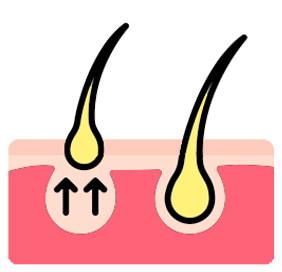Baldness
Baldness does not have a simple pattern of inheritance. The chances of developing baldness are determined by a complex set of genes inherited from each parent, as well as by other factors. The calculation results are for informational purposes only.
Baldness

Baldness is not only a male problem. Women are also prone to baldness. Baldness is not a disease, but a condition that is influenced by heredity, hormone levels, diet, stress, and the aging process.
With age, everyone's hair becomes thinner. However, up to 40% of men and women suffer from more noticeable baldness. In men, this process begins at the age of 20-30, and in women, usually after menopause. By the age of 80, about 80% of men and 50% of women show signs of baldness.
Hair loss usually occurs in a predictable pattern known as male pattern baldness or female pattern baldness.
How is Baldness Genetically Inherited?
Heredity is the most common cause of hair loss. Scientists have studied the genetic predisposition to baldness in twins. According to the results of the study, it was revealed that in about 80% of cases genetics is responsible for male pattern baldness.
There is a myth that baldness is inherited from the mother, but it seems that the genes of both parents are to blame for this.
Each person's genetic information is contained in chromosomes. Each person has 23 pairs of chromosomes – half from the mother and half from the father. One pair of chromosomes from this set is responsible for the biological sex of a person. Women have two X chromosomes, while men have one X chromosome and one Y chromosome.
Women only pass on the X chromosome to their child. The second chromosome, which determines the sex of the child, is transmitted by the father.
One of the genes responsible for hair loss is located on the X chromosome. According to the research, people with this gene are 2 times more at risk of baldness than those without the gene.
However, at least 63 genes are responsible for baldness, and only 6 of them are on the X chromosome.
Maternal inheritance does play a role. However, men whose fathers suffered from baldness were more likely to develop male pattern baldness than men with fathers who didn’t lose their hair. Approximately 80% of men who show signs of hair loss have fathers with hair loss.
The hereditary pattern of baldness is irreversible. The diagnosis is usually made based on baldness type and similar cases of baldness in family members.
What else causes balding?
Both men and women are prone to baldness. Genetics is just one factor. In addition to genetics, baldness can be caused by other reasons:
Hormonal changes. Both men and women may notice hair loss due to changes in thyroid hormone levels. Women usually notice hair loss due to hormonal changes after menopause, pregnancy or childbirth.
Stress. Stress can actually contribute to hair loss. However, due to stress, you will only lose hair that would have fallen out anyway. And if some hair was not supposed to fall out, then it will soon grow back. In other words, stress can accelerate baldness, but not lead to it.
Nutritional deficiencies can negatively affect hair density.
Medications and supplements. Some medications can cause hair loss (for example, drugs for cancer, arthritis, depression, and others).
Hairstyles and treatments. Some hairstyles that pull your hair tight, as well as hot hair treatments and permanents, can lead to hair loss. This type of hair loss can be temporary or permanent.
It is impossible to determine exactly whether a child will have baldness, but the probability can be calculated. The Hair Loss Genetic Calculator can help you calculate the chance of hair loss based on your family history.